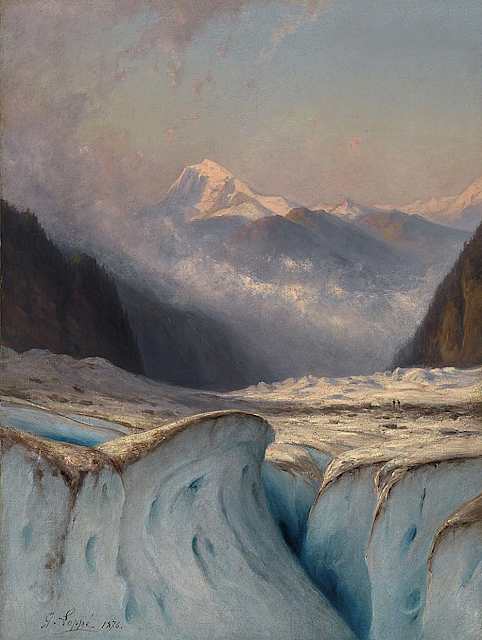In Cliffs of Seelisberg, Lake Lucerne, oil on canvas laid on cardboard, 1861,
About this painting
The hamlet of Seelisberg is located on one of Lake Lucerne’s promontories. Also referred to as the Vierwaldstättersee, the lake was a favourite haunt of Calame. The shores of the lake have changed little since this daring and vertiginous view over the cliffs was painted. This oil sketch echoes Caspar David Friedrich’s sublime Cliffs at Rügen in the Oskar Reinhart Museum in Winterthur which also has an important collection of Calame paintings on public display.
The Oberbauenstock peak (2,117m -6,946 ft) is a mountain of the Urner Alps, overlooking Lake Lucerne in Central Switzerland. Its summit is located on the border between the cantons of Nidwalden and Uri. The small resort of Seelisberg is situated like a peninsula and surrounded by the Vierwaldstättersee with majestic views of lake and mountains. The historically symbolic Rütli Meadow, legendary founding site of the Swiss Confederation, also belongs to Seelisberg.
The painter
Alexandre Calame was a Swiss painter. He was the son of a skillful marble worker in Vevey. His father lost the family fortune, and Alexandre Calame was forced to work in a bank at the age of 15. When his father fell from a building and then died, the young Calame provided for his mother.
In his spare time he began to practice drawing small views of Switzerland. In 1829 he met his patron, the banker Diodati, who made it possible for him to study under landscape painter François Diday. After a few months he decided to devote himself fully to art.
In 1835, he began exhibiting his Swiss-Alps and forest paintings in Paris and Berlin. He became quite well known, especially in Germany, although Calame was more a drawer than an illustrator. He is associated with the Dusseldorf school of painting. In 1842 he went to Paris and displayed his works Mont Blanc, the Jungfrau, the Brienzersee, the Monte Rosa and Mont Cervin. He taught in Geneva, where Adolf Mosengel was one of his pupils.
He went to Italy in 1844 and brought back from Rome and Naples countless paintings, among them one of the ruins of Paestum (in the city museum in Leipzig). He showed that he was capable of understanding Italian nature; but the Alps remained his speciality.
The glaciers, emerald-green, white foaming mountain water, which split the trees during the storm, and the whipped clouds, the multi-colored rocks, half masked from fog, in the rays of the gleaming sun, are those things, which he knew to be true to nature.
One of his most ingenious works is the representation of the four seasons and times of the day in four landscapes, a spring morning in the south, a summer midday in the Nordic flatlands, an Autumn evening, and a winter night on a mountain. He became popular with these large works, and his popularity grew with smaller pieces and lithographies, namely 18 studies of Lauterbrunnen and Meiringen and the 24 sheets of Alpine passes. These were widespread in France, England, and Germany and are still today used to teach this style of painting.
______________________________
2020 - Wandering Vertexes..
by Francis Rousseau














-%20The%20mattherhorn%20from%20%20Riffelsee-%20John%20Mitchell%20gallery%20London%20.png)
